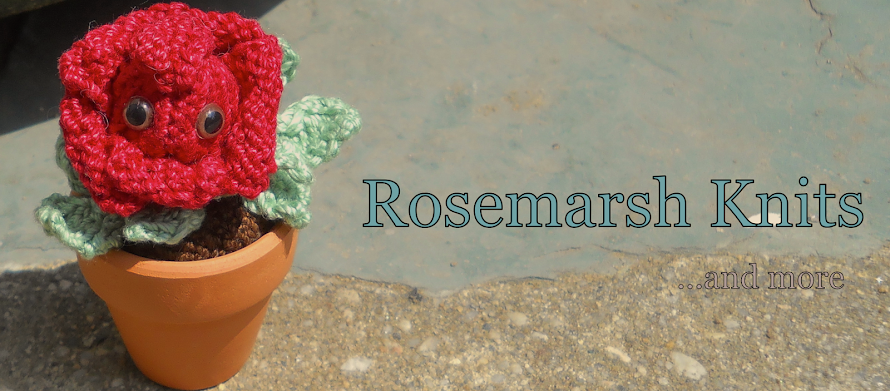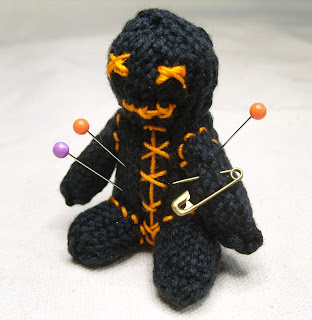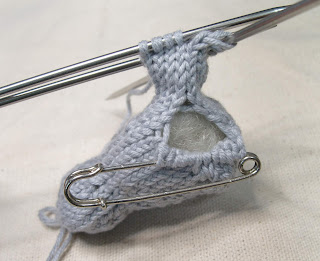So after the obese squirrel, I wasn't in a rush to create a new ornament. I felt like that rotund fellow covered my bases for the rest of the year, until Puffits and I upgraded our tree from a modest three-footer to a very impressive pre-lit five-footer. It's very extravagant, so much so that it felt like an excuse to get some clip-on fake candles. I friggin' love those phony Christmas tree candles.
 |
| The naughty bunny below the tree is not a present; she lives here. |
The larger tree also put me in an ornament making mood, though not enough of one to crank out a new pattern. Instead, I decided to revise some of my older, non-ornament amigurumi into Christmasy versions.
If you're thinking of attempting any of the below, I am sorry for the lack of details. This is really more of a show-and-tell than an instruction. I can say that two out of the three really don't require you to knit any extra bits. For the like two people that actually work from my patterns, I've seen how you folks do your own remixing. I have every confidence you can figure this stuff out and make it better. Just the same, I'll try to recount as many of the steps I took.
Of course, if there's a truly overwhelming response--like say, from three or four people, all begging for detailed patterns to make the following projects--I will gladly provide them. Not until next year though. I mean c'mon.
So let's start with the simple yet finicky...
Christmas Spider
To make this one, I just worked the Spooky Sparkly Spider pattern in metallic crochet thread (Aunt Lydia's Metallic 10 in silver). I didn't do any colorwork--well, I did at first, in gold, but it looked just a little too gaudy, even for Christmas. The single color decision was for the best. If you've ever worked with a metallic plyed or sparkle yarn, you know how much of a head/hand ache it is. The stuff is course, splitty, and twists up anywhere there is the slightest slack.
It doesn't seem to matter how the stuff is plyed. I experienced the same difficult using a chain-ply glitter yarn for my sparkly knit Jumping Spider. I love the result but only because memory never fully retains pain. I'm actually thinking about trying another one as I type this. Stop it!
 |
| Currently our tree-topper until Puffits woodturns something more conventional. |
Okay, so once the spider was knit, single color, it's just a matter of further sparkling it up to make it suitable as a Christmas tree spider. Silver seed beads for the eyes and a blingy crystal on the abdomen did the trick for my tastes. When attaching all this stuff, I used nylon beading chord. I used the same to create a loop for spider suspension.
As I alluded on Twitter, a Christmas spider is backed by tradition. Even if it wasn't, I'd still have some in my tree. Not sure if this is obvious, but I'm very fond of spiders and I don't understand why they aren't constantly adored and celebrated by all.
Even if you don't share my love for them, here's why you might still have one in your Christmas tree.
A woman was hard at work preparing her home for a Christmas celebration. In the process of cleaning and decorating, the spiders in the house hid in the attic, as not to be swept up or dusted away. When the house quieted later that night, they returned downstairs to find all the beautiful decorations and a lovely tall tree. They explored all these new things excitedly, eager to be part of the glittering festivity. Behind them they left strings of grey silk, unknowing dulling the shine of the woman's hard work. When St. Nicholas arrived at the house, he saw how the spiders had so enjoyed the scene but also feared that the woman would be heartbroken when she'd wake to see her decorations covered in webs. St. Nicholas then transformed the grey webs into threads of silver and gold, further beautifying the home.
The legend is said to explain the tradition of tinsel inclusion on Christmas trees and why it's lucky to have a spider of some sort in your tree. I try to include at least several each year.
 |
| This silverly little friend is the newest. |
Gingerbread VooDude
I think I mentioned modifying the recent Tiny VooDoo Doll pattern into a gingerbread man at some point in that post. It was easier than I expected.
I haven't yet tried a fully-stuffed, sitting-upright version. Instead the result resembles the thicker cookies I make. I know it's controversial, but I like a thicker, chewer gingerbread. The trick is extra molasses.
When it comes to knitting them, the trick is under-stuffing and flatting them as you go. Instead of the short rows that enable the VooDude to sit up right, I just knit an extra four rounds before dividing for the legs. I think that amounts to a decent gingerbread man torso. The arms are still the same, just keep them barely stuffed and flatten them out before and after attaching to the body.
Now, the picture makes it quite clear, but I still want to emphasize that I am crap at embroidery. It requires that I actually look at what I'm doing and think about it before I do it. Frankly, that's not my style. I trust you'll do better.
I tried safety eyes on the larger fellow and embroidered on the smaller. I remain unsure of which I prefer.
Some white glittery yarn was haphazardly stitched in place for the icing cuffs and smile. The green buttons are ribbon that's been overlapped. Feel free to use actual small buttons or whatever you can attach that will look like candy or icing. I didn't have any that I liked but I did find Dress It Up buttons in glittery candy canes and gumdrops.
Christmas Pudding Spite
I've noticed a increase in the amount of Christmas pudding iconography in recent years, which is a little weird because I've never actually encountered any sort of plum or boiled pudding in reality.
Here in the States, or at least in my region/personal experience, it's cookies, pies, red and green nem-em-nems, and yes, Christmas Donuts. And while I grew up with fruit cake and panetonne always being present on the table, I'd never see anyone actually cut into it--let alone eat it. It might as well've been a candle holder.
I never tasted nor met the ole Christmas pudd in person but it's easy to recognize similarities in its stout dome shape and the structure of the Fungispite.
Like the Christmas spider, there's nothing to change from the original pattern. The yarn just needs to be a good pudd color. The add-ons are what finishes the job.
The icing is made by casting on about five or six stitches and joining in the round to make a cap. I increased around evenly--every other stitch and then every two stitches--until the circle was just wide enough to top the sprite's head, figure about four rounds. Then I created the drips.
I started by binding off two or three stitches, then I knit across three or four stitches, turned without wrapping to purl, and turned again, essentially creating just enough length to indicate a drip. I decreased at the first and last stitch and then drew-through. I cut the yarn, reattached it to bind off an additional two or three stitches, and then worked back and forth across a few more to create the next drip. I varied the width and length of each and ended up with about five drips with enough of a gap between each to fit around the sprite's eyes--like a little sugary powdered wig...with some strange bangs.
There were a lot of ends to weave in and some that were used to attach the end and sides of each drip to the sprite.
It was then time to move on to the holly garnish. The knitted berries on the larger sprite were made by casting on two stitches, increasing several times in both, and then drawing through all and pulling tight, kind of like making a freestanding bauble stitch. Apparently I didn't want to do it again with the thinner crochet thread so I used beads. I think I like the glassy sheen on the beads better, though it is more cherry-like. I don't know if that's a issue with traditional puds. It shouldn't be. It's called a plum pudding but I understand it's loaded with raisins. Ugh.
With the holly leaves, I'm not even sure I can describe what I did in any helpful way. I cast-on like six or seven stitches, knit back and forth on two or three of them, and then bound off those few before doing the same with those that remained. My intent was the create a spot of dark green with a jagged edge like a holly leaf. I don't think the result was very convincing but it didn't seem to matter when it all came together on something so small.
I could probably think of a better way to do it if I were to make a proper pattern, which I'm not going to do unless, as mentioned, there's quite a clamor for it.
So there you have it. Merry all the things. Merry nothing as well, because sometimes the nothing is the best part when there is so much something happening, as there tends to be this time of year.
And whatever this year brought, I really do hope 2020 is better. I aim to keep making stuff either way and I thank you if you're along for it.




























